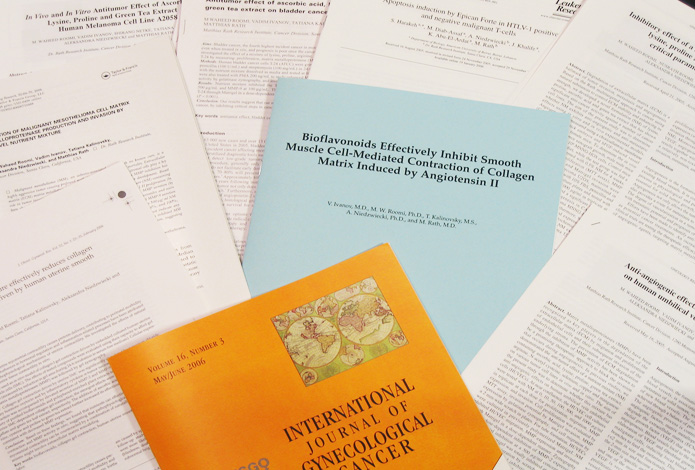 These selected publications present Dr. Rath's scientific discoveries and the foundation of a new approach to heart diseases, cancer, infectious diseases, and many other health problems. Among them a new understanding of an impact of a loss of vitamin C production by humans on their further development and susceptibility to certain diseases.
These selected publications present Dr. Rath's scientific discoveries and the foundation of a new approach to heart diseases, cancer, infectious diseases, and many other health problems. Among them a new understanding of an impact of a loss of vitamin C production by humans on their further development and susceptibility to certain diseases.
A New Era in Medicine (1993)
Rath M. Journal of Orthomolecular Medicine, 8:134-135.
This article proposes that, in contrast to the past, the 21st century will see the eradication of major diseases, such as CVD, and the establishment of nutritional medicine as an essential part of the healthcare system. Skepticism and bias against nutritional supplements will be replaced by acceptance of vitamins and essential nutrients as safe and affordable preventative and therapeutic agents, based on an objective scientific attitude towards nutrient medical research.
View full paper
Unified Theory of Human Cardiovascular Disease Leading the Way to the Abolition of This Disease as a Cause for Human Mortality (1992)
Rath M, Pauling L. Journal of Orthomolecular Medicine, 7: 5-15.
In contrast to current therapeutic approaches, which target individual pathomechanisms or specific risk factors for CVD, this paper proposes a unified pathogenetic and therapeutic approach based on genetic, metabolic, evolutionary and clinical evidence - ascorbate deficiency. Chronic ascorbate deficiency leads to loosening of the connective tissue in the vascular wall and compensatory deposition of Lp(a) (lipoprotein(a)) and fibrinogen/fibrin.
View full paper
Plasmin-Induced Proteolysis and the Role of Apoprotein(a), Lysine, and Synthetic Lysine Analogs (1992)
Rath M, Pauling L. Journal of Orthomolecular Medicine, 7:17-23.
Proteolytic degradation of extracellular matrix (ECM) by the protease plasmin is a universal mechanism, determining human health and disease. Under physiological conditions, this leads to cell migration and organ remodeling; under pathological conditions, to sustained degradation of the ECM, as associated with cancer and viral spread, as well as cardiovascular disease. In this paper, apoprotein(a), lysine and synthetic lysine analogs are discussed as inhibitors of plasmin-induced proteolysis and proposed as natural therapeutic options.
View full paper
Solution to the Puzzle of Human Evolution (1992)
Rath M. Journal of Orthomolecular Medicine, 7:73-80.
This article discusses the rationale for the proposal that the underlying genetic precondition for the evolution of man was the loss of endogenous ascorbate production about 40 million years ago. This genetic mutation became the basis of the dramatic acceleration of human evolution and a quadruplication of the brain size in the recent 2.5 million years. Scurvy, the greatest threat to evolutionary survival of ascorbate-deficient man during the Ice Age, led to survival genetic features: Lp(a) for stabilizing the vascular wall and apo(a) to increased brain size, intelligence and fertility.
View full paper
Solution to the Puzzle of Human Cardiovascular Disease: Its Primary Cause Is Ascorbate Deficiency, Leading to the Deposition of Lipoprotein(a) and Fibrinogen/Fibrin in the Vascular Wall (1991)
Rath M, Pauling L. Journal of Orthomolecular Medicine, 6:125-134.
This article proposes that human cardiovascular disease is primarily a degenerative disease, resulting from the accumulation of lipoprotein(a), which is increased by low ascorbate concentrations. Ascorbate deficiency results from the inability of humans to synthesize endogenous ascorbate combined with an insufficient dietary ascorbate intake. Chronic ascorbate deficiency leads to extracellular accumulation of lipoprotein(a) and fibrinogen/fibrin, the hallmarks of the atherosclerotic lesion.
View full paper
Lipoprotein (a) Is a Surrogate for Ascorbate (1990)
Rath M. Proceedings of the National Academy of Sciences, 87: 6204-6207.
The concept that lipoprotein(a) is a surrogate for ascorbate is suggested by the fact that this lipoprotein is found generally in the blood of primates and the guinea pig, which have lost the ability to synthesize ascorbate, but only rarely in other animals. Properties shared with ascorbate, in accordance with this hypothesis, are the acceleration of wound healing and of cell repair mechanisms, strengthening of extracellular matrix (as in blood vessels), and prevention of lipid peroxidation. Evidence supporting this hypothesis is discussed.
View full paper
Immunological Evidence for the Accumulation of Lipoprotein(a) in the Atherosclerotic Lesion of the Hypoascorbemic Guinea Pig (1990)
Rath M. Proceedings of the National Academy of Sciences, 87: 9388-9390.
Atherosclerosis was induced in three guinea pigs by dietary ascorbate depletion. Using SDS/PAGE and subsequent immunoblotting, Lp(a) was identified as accumulating in the atherosclerotic plaque. Furthermore, adequate amounts of ascorbate (40 mg/kg body weight/day) prevented development of atherosclerotic plaques and accumulation of Lp(a). Guinea pigs were chosen for this study as, similar to humans, they lack endogenous ascorbate production.
View full paper